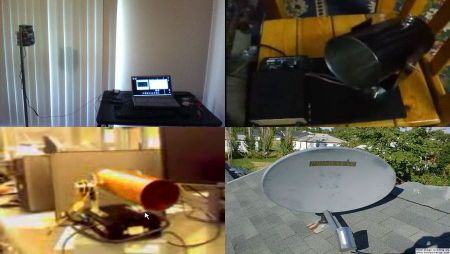Here is a classic project used to increase wireless signal strength. Cantennas focus using a waveguide very much like a magnifying glass focuses light. [Robert] made a Natural Light beer cantenna, pictured in the upper left. His approach used three beer cans, a paper towel holder, and a shower curtain rod. On the tipline, he noted a signal boost from 11Mbps to 54Mbps. This is certainly something we can hack together if our room lacks adequate signal. Read about parabolic and seeking versions after the break.
wireless328 Articles
Crack WEP Using BackTrack

Lifehacker wrote a guide for cracking a WiFi network’s WEP password using BackTrack. BackTrack is a Linux live CD used for security testing and comes with the tools needed to break WEP. Not just any wireless card will work for this; you need one that supports packet injection. The crack works by collecting legitimate packets then replaying them several times in order to generate data. They point out that this method can be hit-or-miss, especially if there are few other users on the network, as the crack requires authenticated packets. We covered cracking WEP before, but using BackTrack should smooth out compatibility issues.
Firework Ignitors And Controllers Roundup

With the 4th of July around the corner, we thought it would be a good idea to give a controller wrap up and show you how to make some ignitors. Last year we covered a microcontroller based fireworks launcher. If you like the idea of a controller but don’t want to run all the wire, we have the wireless fireworks controller. Adding a little twist to the wireless scene are cell phone triggered fireworks. Maybe controllers are not your cup of tea, you could try to microwave your fireworks. After the break we show you how to make ignitors from a diode and a match.
Continue reading “Firework Ignitors And Controllers Roundup”
Wireless Arduino Cat Food Dispenser

Reader, [Andres Leon], has two adorable cats with very specific dietary needs. Instead of altering his schedule, he donned his hacking hat and designed a very solid cat food dispenser. The dispenser consists of a rotating drum with a slot in it and a PVC pipe Y-fitting to distribute the food evenly. The brains of the machine is an Arduino Deumillanove and an XBee module. The unit can be controlled by a web interface or it can run completely standalone. [Andres] ran into a problem where the drum’s resistance to turning varied based on how much food was inside. He solved this with a clever laser position indicator. A piece of plywood is lined up with the slot at the top so that whenever the slot is facing up it keeps the laser from shining on a photoresistor. The cats were afraid of the servo noise at first, but now they run to their bowls whenever they hear it.
Ekahau HeatMapper Maps Out WiFi Signals

The term ‘warwalking’ isn’t used very often, but the Ekahau HeatMapper adds a new tool to the pod bound hacker’s arsenal. The tool maps out wireless access points as well as their signal strength within a facility. A test of the HeatMapper on a map made with AutoDesk Dragonfly accurately determined the location of a router within 3 feet and helped tune the angle it needed to be at for maximum range. Ekahau made a fantastically cheesy promotional video for their product, which is viewable after the jump. The program is free of charge, but unfortunately only runs on windows, so mac and *nix users are out of luck, though it might run under wine.
Keykeriki: Wireless Keyboard Sniffer
[vimeo = 4990390]
Remote-Exploit.org is releasing Keykeriki, a wireless keyboard sniffer. The project is both open source hardware and software. you can download the files on their site. Right now you can’t get a pre made board, but they plan on releasing one soon. The system can be upgraded with “backpacks” or add on modules. One of these is going to be an LCD that displays the keystrokes of the keyboard you are sniffing. Another is supposed to serve as an interface to your iPhone. Right now it has the ability to decode Microsoft wireless keyboards, but the Logitech pieces should be added soon.
Wireless Portable USB Tether

[Pete] has put together a fairly simple writeup on building a wireless USB tether for your DSLR. He’s basically using a pair of USB wireless adapters and a battery pack. In his original version, he did some slight modification to the dock that powers the USB dongle, adding his own battery pack too. He notes that this whole project can be done without the effort he put into it, at a little more expense. The only improvement we think would be nice would be a better way to package it to keep it out of the way while you shoot.











